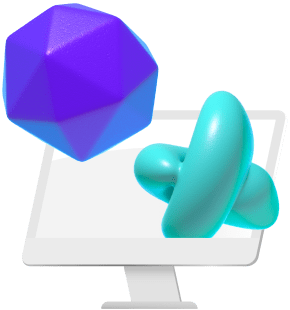As a designer or digital artist, getting the best Software to help you achieve your goals is a top priority. This time we’ll look at Blender vs. ZBrush and cover their most important features like User Interface (UI), Sculpting, Rending, and Prices. Let’s get stuck in!

Photo by Erick Butler on Unsplash
Quick Overview of Blender and ZBrush
Blender and ZBrush belong to different sides of the digital sculpting world. ZBrush, a sculpting beast, is hailed as the king of sculpting software. Blender, on the flip side, is an all-in-one 3D creation suite, where sculpting is just one of its many features.
An excellent illustration to compare Blender vs. ZBrush is to describe one as a Jeep and the other as an F1 car. A Jeep will get destroyed if paired with an F1 car on a track. Likewise, put an F1 car on a 4X4 track, and you won’t get far.
While Blender is an all-purpose 3D software package, ZBrush specializes in Sculpting. The nature of their design makes them inherently different and, to a degree, incomparable. Keep this in mind as we review various features of this software.
User Interface and Workflow
Blender
Blender’s user interface (UI) is flexible and customizable. As an artist, you can personalize your workspace by rearranging and resizing different areas. The UI includes menus, toolbars, and panels for accessing features, and it supports keyboard shortcuts for efficiency.
Blender provides various editor types for different tasks and can easily switch between them. Users can create and save multiple workspaces for specific workflows. Although Blender’s UI might seem overwhelming to beginners, learning resources are available to help them navigate and utilize its features effectively.
ZBrush
ZBrush’s user interface (UI) is designed to provide a streamlined and intuitive experience for digital sculpting and modeling. The UI consists of different panels and floating palettes that an artist can customize according to their preference. ZBrush utilizes a combination of menus, icons, and sliders to access its extensive tools and features. The UI focuses on providing quick access to sculpting brushes, materials, and subtotals, allowing artists to manipulate their models efficiently.
ZBrush also offers a unique 2.5D/3D hybrid canvas that enables artists to paint and sculpt simultaneously. While ZBrush’s UI may take some time to familiarize yourself with due to its depth and complexity, it offers powerful tools for professional sculpting workflows.
Modeling Capabilities
Blender
Blender excels in modeling, offering various tools for 3D artists. It allows you to create precise geometry using polygonal modeling, subdivision surfaces for smooth shapes, and sculpting for intricate details. With its modifier system, you can experiment without altering the base mesh, and the node-based Geometry Nodes enable the creation of procedural structures. Blender’s versatility and active community make it a popular choice.
Zbrush
ZBrush is renowned for its powerful modeling capabilities, tailored specifically for digital sculpting. It provides an intuitive and immersive sculpting experience, allowing artists to manipulate virtual clay easily. ZBrush offers dynamic and customizable brushes, enabling intricate detailing and organic sculpting.
It also features tools like ZRemesher for automatic topology optimization, DynaMesh for dynamic mesh resolution, and ZSpheres for creating base structures. ZBrush’s focus on sculpting and its innovative features make it a preferred choice for artists seeking high-quality, detailed 3D models.
Sculpting and Texturing
Blender
Blender excels in sculpting, enabling artists to create detailed and organic models. It offers various sculpting brushes for shaping, smoothing, and adding intricate details. Blender’s sculpting tools feature dynamic topology, allowing artists to adjust the model’s geometry as they sculpt.
Blender integrates texture painting, allowing artists to paint directly on the 3D models and create intricate textures.
ZBrush
ZBrush is widely recognized for its unparalleled sculpting capabilities. It offers an array of sculpting brushes and features that cater specifically to digital sculpting. ZBrush’s brushes allow for detailed sculpting and surface manipulation, enabling artists to create highly realistic and intricate models.
ZBrush also excels in texturing with its advanced poly painting system, which allows artists to paint directly onto the 3D models and achieve high-quality textures.

Photo by Roi Dimor on Unsplash
Rendering and Visualization
Blender
Blender features a comprehensive rendering engine called Cycles, which can produce high-quality, photorealistic renders. Cycles use path tracing and support advanced rendering techniques such as global illumination, caustics, and volumetrics. Blender also offers real-time rendering with its EEVEE engine, which provides interactive feedback and is suitable for quick previews and animations.
Additionally, Blender allows for extensive customization and node-based shader editing, giving artists complete control over materials and textures. However, certain issues have risen during rendering, like Blender limiting how much you can zoom in. These are easily fixed, though.
ZBrush
While ZBrush is primarily known for its sculpting capabilities, it also offers to render functionalities through its integrated renderer called BPR (Best Preview Render). Although less feature-rich than Blender’s Cycles, BPR allows artists to generate basic renders directly within ZBrush.
It provides a variety of material presets and lighting options to enhance the visualization of sculpted models. However, ZBrush relies on exporting the models to external rendering software like KeyShot for more advanced and photorealistic rendering.
Blender’s rendering capabilities outshine ZBrush’s built-in renderer. With the powerful Cycles engine and real-time EEVEE rendering, Blender provides artists with extensive control over lighting, materials, and effects, resulting in highly realistic renders.
In contrast, ZBrush’s rendering capabilities are more basic and intended for preview purposes. Its users have to rely on dedicated rendering software for advanced rendering requirements.
Learning Curve and Resources
Blender
Blender has a learning curve but has become more user-friendly. They have a wide range of learning resources, including tutorials and a community that is always ready to give input. Blender’s popularity and open-source nature mean there is plenty of online tutorials and educational content to help users learn at their own pace.
ZBrush
ZBrush has a steep learning curve, especially for beginners in 3D sculpting. Its interface and sculpting workflow requires time and practice to master. However, ZBrush offers helpful documentation and tutorials. There are online communities and forums where users can find support and learn from others. Pixologic, the company behind ZBrush, also provides training programs and workshops to help users improve their skills and get the most out of the software.
Pricing and Licensing
Blender
Blender is free and open-source. You can download and use it without paying any licensing fees. Its open-source nature encourages community involvement, with users and developers working together to enhance the software over time. As a newbie to 3D design, Blender would be the suggested software.
ZBrush
As a specialized 3D sculpting software, ZBrush requires you to pay. You will need to purchase a license agreement to use the software. This includes perpetual licenses and subscription-based plans. The pricing structure of ZBrush varies depending on the license type and whether it is for personal or professional use. ZBrush has two pricing categories, one for individuals and another for teams. The prices are as follows:
Individuals:
- Maxon One- €170.90/mo
- Cinema 4D- €103.32/mo
- Red Giant- €89.79/mo
- RedShift- €46.74/mo
- Universe- €33.21/mo
- ZBrush- €43.05/mo
- Forger- €1.99/mo
Team:
- Maxon One- €1597.77/mo
- Cinema 4D- €1044.27/mo
- Red Giant- €835.77/mo
- RedShift- €343.17/mo
- C4D + Redshift- €1234.92/mo
- ZBrush- €448.95/mo
- C4D + RG Complete- €1382.52 /mo
There is also the option to do a yearly subscription.
Use Vagon to Improve Your PC Efficiency
Software like ZBrush and Blender require tons of processing power from your device, which may affect their functionality while you work. This also has massive implications for rendering times. We all know that slow rendering is annoying.
Thankfully, you can use a Vagon to ensure your device runs smoothly and efficiently. Take a look at what Vagon has to offer. We promise you won’t be disappointed!

Final Comparison
As we wrap this up, there is a clear rift between Blender and ZBrush. While Blender is a Jeep you can take anywhere, it does have its limits. It is perfect for beginners and those looking to learn. Whereas ZBrush is an F1 car with one purpose: to speed towards being the king of digital sculpting.
If you want to lean more toward a professional career in sculpting, then ZBrush is the software for you. If not, then Blender has sufficient features for any 3D modeler and is free.




